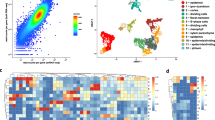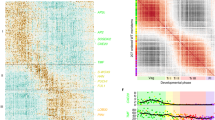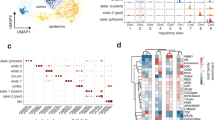Abstract
Understanding complex biological systems requires functional characterization of specialized tissue domains. However, existing strategies for generating and analysing high-throughput spatial expression profiles were developed for a limited range of organisms, primarily mammals. Here we present the first available approach to generate and study high-resolution, spatially resolved functional profiles in a broad range of model plant systems. Our process includes high-throughput spatial transcriptome profiling followed by spatial gene and pathway analyses. We first demonstrate the feasibility of the technique by generating spatial transcriptome profiles from model angiosperms and gymnosperms microsections. In Arabidopsis thaliana we use the spatial data to identify differences in expression levels of 141 genes and 189 pathways in eight inflorescence tissue domains. Our combined approach of spatial transcriptomics and functional profiling offers a powerful new strategy that can be applied to a broad range of plant species, and is an approach that will be pivotal to answering fundamental questions in developmental and evolutionary biology.
This is a preview of subscription content, access via your institution
Access options
Access Nature and 54 other Nature Portfolio journals
Get Nature+, our best-value online-access subscription
$29.99 / 30 days
cancel any time
Subscribe to this journal
Receive 12 digital issues and online access to articles
$119.00 per year
only $9.92 per issue
Buy this article
- Purchase on Springer Link
- Instant access to full article PDF
Prices may be subject to local taxes which are calculated during checkout




Similar content being viewed by others
References
Ståhl, P. L. et al. Visualization and analysis of gene expression in tissue sections by spatial transcriptomics. Science 353, 78–82 (2016).
Lee, J. H. et al. Highly multiplexed subcellular RNA sequencing in situ. Science 343, 1360–1363 (2014).
Ke, R. et al. In situ sequencing for RNA analysis in preserved tissue and cells. Nat. Methods 10, 857–860 (2013).
Crosetto, N., Bienko, M. & van Oudenaarden, A. Spatially resolved transcriptomics and beyond. Nat. Rev. Genet. 16, 57–66 (2015).
Wang, Z., Gerstein, M. & Snyder, M. RNA-Seq: a revolutionary tool for transcriptomics. Nat. Rev. Genet. 10, 57–63 (2009).
Ortiz-Ramírez, C. et al. A transcriptome atlas of Physcomitrella patens provides insights into the evolution and development of land plants. Mol. Plant 9, 205–220 (2015).
Rensink, W. A. & Buell, C. R. Microarray expression profiling resources for plant genomics. Trends Plant Sci. 10, 603–609 (2005).
Birnbaum, K. et al. A gene expression map of the Arabidopsis root. Science 302, 1956–1960 (2003).
Brady, S. M. et al. A high-resolution root spatiotemporal map reveals dominant expression patterns. Science 318, 801–806 (2007).
Yadav, R. K., Tavakkoli, M., Xie, M., Girke, T. & Reddy, G. V. A high-resolution gene expression map of the Arabidopsis shoot meristem stem cell niche. Development 17, 2735–2744 (2014).
Deal, R. B. & Henikoff, S. The INTACT method for cell type – specific gene expression and chromatin profiling in Arabidopsis thaliana. Nat. Protoc. 19, 56–68 (2011).
Nelson, T., Tausta, S. L., Gandotra, N. & Liu, T. Laser microdissection of plant tissue: what you see is what you get. Annu. Rev. Plant Biol. 57, 181–201 (2006).
Anjam, M. S. et al. An improved procedure for isolation of high-quality RNA from nematode-infected Arabidopsis roots through laser capture microdissection. Plant Methods 12, 25 (2016).
Gautam, V., Singh, A., Singh, S. & Sarkar, A. K. An efficient LCM-based method for tissue specific expression analysis of genes and miRNAs. Sci. Rep. 6, 21577 (2016).
Takacs, E. M. et al. Ontogeny of the maize shoot apical meristem. Plant Cell 24, 3219–3234 (2012).
Jiao, Y. et al. A transcriptome atlas of rice cell types uncovers cellular, functional and developmental hierarchies. Nat. Genet. 41, 258–263 (2009).
Cosgrove, D. J. Growth of the plant cell wall. Nat. Rev. Mol. Cell Biol. 6, 850–861 (2005).
Bourgaud, F., Gravot, A., Milesi, S. & Gontier, E. Production of plant secondary metabolites: a historical perspective. Plant Sci. 161, 839–851 (2001).
Li, Y., Pearl, S. A. & Jackson, S. A. Gene networks in plant biology: approaches in reconstruction and analysis. Trends Plant Sci. 20, 664–675 (2015).
Nystedt, B. et al. The Norway spruce genome sequence and conifer genome evolution. Nature 497, 579–584 (2013).
Islam, S. et al. Quantitative single-cell RNA-seq with unique molecular identifiers. Nat. Methods 11, 163–166 (2014).
Fu, G. K., Hu, J., Wang, P.-H. & Fodor, S. P. A. Counting individual DNA molecules by the stochastic attachment of diverse labels. Proc. Natl Acad. Sci. USA 108, 9026–9031 (2011).
Koonjul, P. K., Brandt, W. F., Farrant, J. M. & Lindsey, G. G. Inclusion of polyvinylpyrrolidone in the polymerase chain reaction reverses the inhibitory effects of polyphenolic contamination of RNA. Nucleic Acids Res. 27, 915–916 (1999).
Petterle, A., Karlberg, A. & Bhalerao, R. P. Daylength mediated control of seasonal growth patterns in perennial trees. Curr. Opin. Plant Biol. 16, 301–306 (2013).
Street, N. R. et al. A cross-species transcriptomics approach to identify genes involved in leaf development. BMC Genomics 9, 589 (2008).
Street, N. R., Jansson, S. & Hvidsten, T. R. A systems biology model of the regulatory network in Populus leaves reveals interacting regulators and conserved regulation. BMC Plant Biol. 11, 13 (2011).
Schmid, M. et al. A gene expression map of Arabidopsis thaliana development. Nat. Genet. 37, 501–506 (2005).
Wellmer, F., Alves-Ferreira, M., Dubois, A., Riechmann, J. L. & Meyerowitz, E. M. Genome-wide analysis of gene expression during early Arabidopsis flower development. PLoS Genet. 2, 1012–1024 (2006).
Rubinelli, P., Hu, Y. & Ma, H. Identification, sequence analysis and expression studies of novel anther-specific genes of Arabidopsis thaliana. Plant Mol. Biol. 37, 607–619 (1998).
Irish, V. F. & Sussex, I. M. Function of the apetala-1 gene during Arabidopsis floral development. Plant Cell 2, 741–753 (1990).
Jack, T., Brockman, L. L. & Meyerowitz, E. M. The homeotic gene apetala 3 of Arabidopsis thaliana encodes a MADS box and is expressed in petals and stamens. Cell 68, 683–697 (1992).
Goto, K. & Meyerowitz, E. M. Function and regulation of the Arabidopsis floral homeotic gene PISTILLATA. Genes Dev. 8, 1548–1560 (1994).
Yanofsky, M. et al. The protein encoded by the Arabidopsis homeotic gene AGAMOUS resembles transcription factors. Nature 346, 35–39 (1990).
Van Der Maaten, L. J. P. & Hinton, G. E. Visualizing high-dimensional data using t-sne. J. Mach. Learn. Res. 9, 2579–2605 (2008).
Robinson, M. D., McCarthy, D. J. & Smyth, G. K. Edger: a bioconductor package for differential expression analysis of digital gene expression data. Bioinformatics 26, 139–140 (2009).
Ritchie, M. E. et al. Limma powers differential expression analyses for RNA-sequencing and microarray studies. Nucleic Acids Res. 43, e47 (2015).
Truernit, E., Stadler, R., Baier, K. & Sauer, N. A male gametophyte-specific monosaccharide transporter in Arabidopsis. Plant J. 17, 191–201 (1999).
Alexeyenko, A. et al. Network enrichment analysis: extension of gene-set enrichment analysis to gene networks. BMC Bioinformatics 13, 226 (2012).
Sundell, D. et al. The plant genome integrative explorer resource: plantGenIE.org. New Phytol. 208, 1149–1156 (2015).
Karlebach, G. & Shamir, R. Modelling and analysis of gene regulatory networks. Nat. Rev. Mol. Cell Biol. 9, 770–780 (2008).
Thompson, D., Regev, A. & Roy, S. Comparative analysis of gene regulatory networks: from network reconstruction to evolution. Annu. Rev. Cell Dev. Biol. 31, 399–428 (2015).
Junker, J. P. et al. Genome-wide RNA tomography in the zebrafish embryo. Cell 159, 662–675 (2014).
Marioni, J. C., Mason, C. E., Mane, S. M., Stephens, M. & Gilad, Y. RNA-seq: an assessment of technical reproducibility and comparison with gene expression arrays. Genome Res. 18, 1509–1517 (2008).
Smyth, J. L. Bowman & E. M. & Meyerowitz, D. R. Early flower development in Arabidopsis. Plant Cell 2, 755–767 (1990).
Vickovic, S. et al. Massive and parallel expression profiling using microarrayed single-cell sequencing. Nat. Commun. 7, 1–9 (2016).
Lundin, S., Stranneheim, H., Pettersson, E., Klevebring, D. & Lundeberg, J. Increased throughput by parallelization of library preparation for massive sequencing. PLoS ONE 5, e10029 (2010).
Kopylova, E., Noé, L. & Touzet, H. SortMeRNA: Fast and accurate filtering of ribosomal RNAs in metatranscriptomic data. Bioinformatics 28, 3211–3217 (2012).
The Arabidopsis Genome Initiative. Analysis of the genome sequence of the flowering plant Arabidopsis thaliana. Nature 408, 796–815 (2000).
Tuskan, G. A . et al. The genome of black cottonwood, Populus trichocarpa (Torr. & Gray). Science 313, 1596–1604 (2006).
Dobin, A. et al. STAR: ultrafast universal RNA-seq aligner. Bioinformatics 29, 15–21 (2013).
Anders, S., Pyl, P. T. & Huber, W. HTSeq—a python framework to work with high-throughput sequencing data. Bioinformatics 31, 166–169 (2015).
Costea, P. I., Lundeberg, J. & Akan, P. TagGD: fast and accurate software for DNA tag generation and demultiplexing. PLoS ONE 8, e57521 (2013).
Trygg, J. & Wold, S. Orthogonal projections to latent structures (O-PLS). J. Chemometrics 16, 119–128 (2002).
Kjellqvist, S. et al. A combined proteomic and transcriptomic approach shows diverging molecular mechanisms in thoracic aortic aneurysm development in patients with tricuspid- and bicuspid aortic valve. Mol. Cell. Proteomics 12, 407–425 (2013).
Lindholm, M. E. et al. The impact of endurance training on human skeletal muscle memory, global isoform expression and novel transcripts. PLoS Genet. 12, e1006294 (2016).
Martens, H., Høy, M., Westad, F., Folkenberg, D. & Martens, M. Analysis of designed experiments by stabilised PLS regression and jack-knifing. Chemom. Intell. Lab. Syst. 58, 151–170 (2001).
Du, Z., Zhou, X., Ling, Y., Zhang, Z. & Su, Z. agriGO: a GO analysis toolkit for the agricultural community. Nucleic Acids Res. 38, 64–70 (2010).
Huang, D. W., Sherman, B. T. & Lempicki, R. A. Bioinformatics enrichment tools: paths toward the comprehensive functional analysis of large gene lists. Nucleic Acids Res. 37, 1–13 (2009).
Subramanian, A. et al. Gene set enrichment analysis: A knowledge-based approach for interpreting genome-wide expression profiles. Proc. Natl Acad. Sci. 102, 15545–15550 (2005).
Schmitt, T., Ogris, C. & Sonnhammer, E. L. L. Funcoup 3.0: Database of genome-wide functional coupling networks. Nucleic Acids Res. 42, 380–388 (2014).
Alexeyenko, A. & Sonnhammer, E. L. L. Global networks of functional coupling in eukaryotes from comprehensive data integration. Genome Res. 19, 1107–1116 (2009).
Jeggari, A. & Alexeyenko, A. NEArender: an R package for functional interpretation of ‘omics’ data via network enrichment analysis. BMC Bioinform. 18, 118 (2017).
Acknowledgements
We thank the Swedish National Genomics Infrastructure hosted at SciLifeLab, the National Bioinformatics Infrastructure Sweden (NBIS) for providing computational assistance, and the Uppsala Multidisciplinary Center for Advanced Computational Science (UPPMAX) for providing computational infrastructure. This work was supported by Knut and Alice Wallenberg Foundation, and Swedish Research Council. N.R.S. and B.K.T. are supported by the Trees and Crop for the Future (TC4F) project. This work was supported by a grant to N.R.S. from the Carl Tryggers Stiftelse för Vetenskaplig Forskning.
Author information
Authors and Affiliations
Contributions
S.G. and J.L. designed the project. S.G. developed the plant-specific protocol, performed and guided experiments and data analyses, prepared figures and wrote the manuscript. F.S. and P.L.S. developed the original protocol for mammalian tissue. F.S. contributed to some code used for the analyses. B.K.T. performed experiments. S.V. developed barcoded arrays. J.F.N. developed the alignment and demultiplexing pipeline. A.A. developed the linear model and performed its computations. J.R. performed a part of data analysis and a part of figure preparation. L.S.M. and V.B. provided consultation on plant cell-wall degradation enzymes. C.M. developed the visualization and data sharing tool. J.F.S. provided A. thaliana and P. abies samples, contributed to data interpretation. N.S. provided P. tremula samples, contributed to data interpretation, and guided the development of the visualization tool. A.A., L.S.M., J.F.S., N.R.S. and J.L. edited the manuscript.
Corresponding authors
Ethics declarations
Competing interests
P.L.S. and J.L are founders of a company that holds IP rights to the presented technology.
Supplementary information
Supplementary Information
Supplementary Figures 1-13. (PDF 19503 kb)
Supplementary Table 1
Differential expressed genes between developing and dormant Populus tremula leaf buds. (XLSX 327 kb)
Supplementary Table 2
Number of TP, TN, FP and FN per each tissue domain in A. thaliana replicates. (XLSX 44 kb)
Supplementary Table 3
Linear model P-values per genes and pathways at the macro- and micro-category level. (XLSX 1617 kb)
Rights and permissions
About this article
Cite this article
Giacomello, S., Salmén, F., Terebieniec, B. et al. Spatially resolved transcriptome profiling in model plant species. Nature Plants 3, 17061 (2017). https://doi.org/10.1038/nplants.2017.61
Received:
Accepted:
Published:
DOI: https://doi.org/10.1038/nplants.2017.61
This article is cited by
-
Single-cell and spatial RNA sequencing reveal the spatiotemporal trajectories of fruit senescence
Nature Communications (2024)
-
Plant biotechnology research with single-cell transcriptome: recent advancements and prospects
Plant Cell Reports (2024)
-
Spatial metatranscriptomics resolves host–bacteria–fungi interactomes
Nature Biotechnology (2023)
-
Understanding plant pathogen interactions using spatial and single-cell technologies
Communications Biology (2023)
-
Multiplexed single-cell 3D spatial gene expression analysis in plant tissue using PHYTOMap
Nature Plants (2023)



